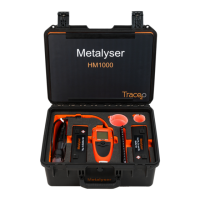Metalyser
®
Portable HM1000
Instruction Manual
v 5.0
The instrument
also consists of:
Stirrer – the
stirrer
is
crucial
to the
operation
of the
instrument
so it needs to be
checked to
ensure
it is working
properly
. It has been designed to minimise turbulence thus
ensuring increased repeatability.
During
a run, look through the
translucent beaker
or
lightly
touch the bottom of the SAB to
determine
that the
stirrer
is rotating when
indicated
on the
handset. If the stirrer fails to rotate, turn the sonde head upside down,
add a few drops of the
Stirrer Oil (do not use any other oil)
down the stirrer shaft at
the base near the sonde head (near where it enters the sonde) and rotate gently to
ensure the lubricant coats the bottom of the shaft.
Sample Analysis Beaker
(SAB)
– the SAB has a fixed volume,
so
that when
full
and
removed
from the water course,
excess
sample water will empty out of the
holes, levelling
off at a constant volume.
Instrument – the instrument is waterproof and robust. A periodic
visual
inspection
to ensure it is not
damaged
and that the
screen
is
readable
will
suffice.
Buffers – the
buffers
should be stored in a dark, cool, dry
environment.
If stored
correctly, the powder buffers
have
a shelf
life
of 3
years, liquid buffers have a shelf life
of one year. Refer
to
individual
buffers for expiry dates.
Standards - The standards should be stored in a dark, cool place and have a
shelf life of 12 months. Refer to standards for expiry dates. Should any
contaminant come into contact with the standards, they should be discarded.
Plating Solutions – The plating solutions should be stored in a dark, cool place
and have a shelf life of one year. Refer to solutions for expiry dates. Should the
efficacy of the plating solution deteriorate before this during use, they should be
discarded and replaced.

